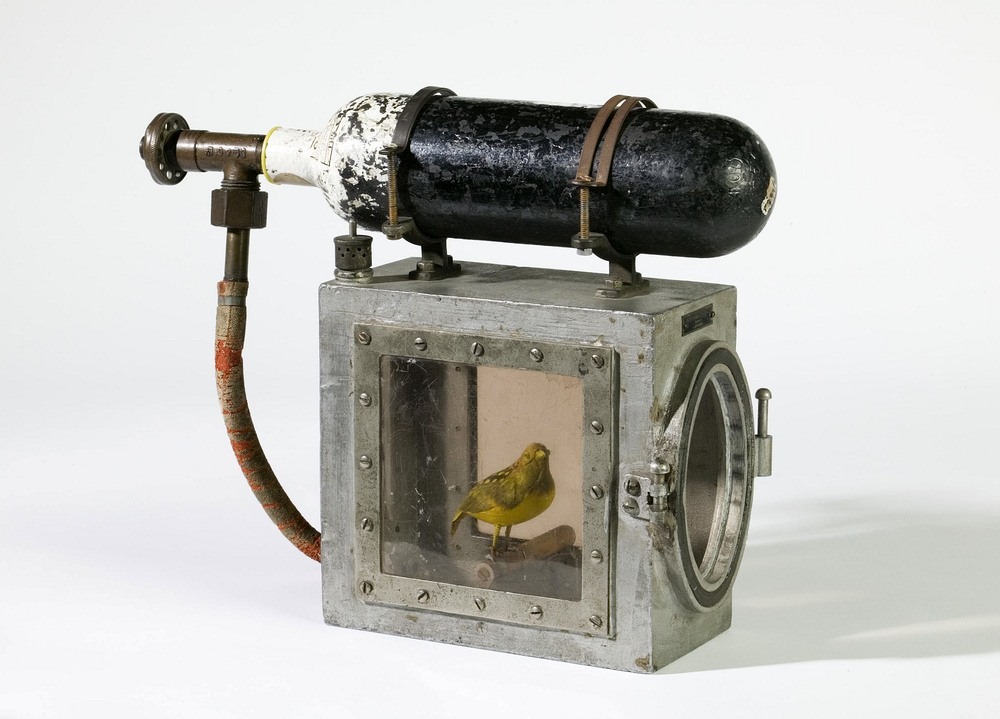
This peculiar device, in the collection of the Science Museum in South Kensington, London, looks like a tiny gas chamber a movie villain would use. Throw in your enemy—in this case, a small innocent canary—close the hatch, turn open the valve to let in poisonous gas from the cylinder above, and then laugh manically as the bird suffocates and die.
In reality, it’s the opposite. This device is used not to kill canaries, but to revive them. The cylinder attached to the top of the metal box contains life giving oxygen. They are known as Canary Resuscitators.
Until about thirty years ago, coal miners used to go down to work carrying canaries with them in glass chambers such as these. Underground mines can contain potentially deadly gases such as carbon monoxide that can form during an accident such as fire or an explosion. The odorless and colorless gas is equally deadly to both humans and canaries alike, but canaries are much more susceptible to the gas, and reacts more quickly and visibly than humans do, thus alerting miners to the presence of the poisonous gas.
When a disaster strikes inside a mine, rescue workers would descend into the mine carrying a canary in a Resuscitator. The glass and metal box has a circular open door in the front to let air in, but a grill prevents the canary from escaping. If there is carbon monoxide in the air, the canary would show signs of distress. It would start swaying noticeably on its perch and eventually fall of it. If the canary loses consciousness, the door to the box would be closed and the valve opened, allowing oxygen from the tank on top to be released and revive the canary. The miners would then evacuate the danger area.

Photo credit: www.healeyhero.co.uk
The idea of using canaries was first proposed by John Haldane, a Scottish physiologist noted for his discoveries of the physiology of breathing and the nature of gases and its effect on the human body. Haldane would famously lock himself up in sealed chambers breathing potentially lethal cocktails of gases while he took notes recording how it felt to be slowly poisoned. During the First World War, Haldane went to the front to identify the poison gas used by the Germans, leading to the invention of the first gas mask.
Haldane also investigated numerous mine disasters, and discovered that carbon monoxide was the lethal constituent that killed most miners after noticing that their bodies were stained cherry-pink—the result of a compound that formed in blood when carbon monoxide combined with hemoglobin.
In the late 1890s, Haldane began experimenting on small animals like white mice and canaries. Small animals have faster metabolism rate, and hence show the effects of carbon monoxide poisoning much earlier even in the presence of small quantities of the noxious gas. Canaries are especially good at detecting toxins in the air because of their specialized respiratory system.

Animation showing the difference between human and bird respiratory system. Image credit: Eleanor Lutz
Like all birds, canaries have a complicated respiratory system designed to collect as much oxygen as possible from the air. This is important for birds because flying uses a lot of energy. Also, birds sometimes fly very high up where there is very little oxygen in the air.
When a bird inhales, it takes in large amount of air relative to its size—a bird's respiratory system takes up 20 percent of the bird's volume, compared to only 5 percent in humans— part of which it stores in small empty spaces called “air sacs” distributed throughout the body of the bird. The rest is directed into the lungs where oxygen and carbon dioxide switch places. When the bird exhales, the air stored in the air sacs enters the lungs where another exchange of oxygen and carbon dioxide takes place. So birds are continuously breathing oxygen both when they inhale and when they exhale. This makes them superior at taking oxygen, but also leaves them vulnerable to airborne toxins.
The use of canaries in mines was outlawed in Britain in 1986. At that time, more than 200 canary birds were in duty. They were replaced by electronic detectors which are cheaper and more effective, not to mention more “humane”, for the birds.

Canaries As Poisonous Gas Detectors
 Reviewed by CUZZ BLUE
on
May 16, 2018
Rating:
Reviewed by CUZZ BLUE
on
May 16, 2018
Rating:
 Reviewed by CUZZ BLUE
on
May 16, 2018
Rating:
Reviewed by CUZZ BLUE
on
May 16, 2018
Rating:
No comments: